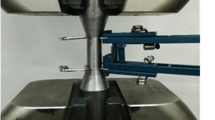Abstract
A combination method of beneficial wrinkle and preform shape is proposed to solve the problem of non-uniform thickness distribution during hydroforming of a variable diameter tubular component. The effect of loading path for the hydroform part and the preform shape are simulated by LS-DYNA. At the same time, the wall thickness deviation of the maximum and minimum of the hydroformed part is considered as the optimal target and the loading path for the preform shape is optimized to obtain the beneficial wrinkles by response surface methodology. Simultaneously, hydroforming experiments were conducted to verify the simulation results. Study shows that the loading path plays an important role in the forming of the beneficial wrinkles, which influence the cracking and the wrinkling defects. Only the loading path is appropriate can the beneficial wrinkles be formed and the wrinkles are flattened in the subsequent calibrating process. Response surface methodology is an effective way to obtain the optimal loading path, and the desired loading path can be achieved by controlling the relationship of the axial feeding and the internal pressure.
Similar content being viewed by others
References
Koç M, Altan T (2001) An overall review of the tube hydroforming (THF) technology. J Mater Process Technol 108(3):384–393
Yuan SJ (2007) Innovative process in tube hydroforming and applications. Proceeding of the second International Conference New Forming Technology, Bremen, pp 1–10
Yuan SJ, Han C, Wang XS (2006) Hydroforming of automotive structural components with rectangular-sections. Int J Mach Tools Manuf 46(11):1201–1206
Han C, Feng H, Yan LD, Yuan SJ (2017) Thickness improvement in non-homogeneous tube hydroforming of a rectangular component by contact sequence. Int J Adv Manuf Technol 92(5–8):2667–2675
Wada M, Mizumura M, Iguchi K, Kaneda H (2014) Large-expansion hydroforming technology achieving three-times expanding. Process Eng 81:2217–2222
Seyedkashi SMH, Naeini HM, Liaghat GH, Mashadi MM, Mirzaali M, Shojaee K, Moon YH (2012) The effect of tube dimensions on optimized pressure and force loading paths in tube hydroforming process. J Mech Sci Technol 26(6):1817–1822
Abdelkefi A, Guermazi N, Boudeau N, Malécot P, Haddar N (2017) Effect of the lubrication between the tube and the die on the corner filling when hydroforming of different cross-sectional shapes. Int J Adv Manuf Technol 87(1–4):1–13
Fiorentino A, Ceretti E, Giardini C (2013) Tube hydroforming compression test for friction estimation-numerical; inverse method, application, and analysis. Int J Adv Manuf Technol 64(5–8):695–705
Tomizawa A, Kubota H, Kurokawa H, Kojima M (2015) Development of tube hydroforming technology using axial movable dies. J Jpn Soc Technol Plast 56(648):40–46
Hwang YM, Hsieh SY, Kuo NJ (2017) Study of large-expansion-ratio tube hydroforming with movable dies. Key Eng Mater 725:616–622
Han C, Yuan SJ, Sun LN (2008) Reduction of friction and calibration pressure by section preform during hydroforming of tubular automotive structural components. Adv Mater Res 44-46:143–150
Tabatabaei SA, Panahi MS, Mashhadi MM, Tabatabee SM, Aghajanzadeh M (2013) Optimum design of preform geometry and forming pressure in tube hydroforming using the equi-potential lines method. Int J Adv Manuf Technol 69(9–12):2787–2792
Yuan SJ, Yuan WJ, Wang XS (2006) Effect of wrinkling behavior on formability and thickness distribution in tube hydroforming. J Mater Process Technol 177(1–3):668–671
Yuan SJ, Cui XL, Wang XS (2015) Investigation into wrinkling behavior of thin-walled 5A02 aluminum alloy tubes under internal and external pressure. Int J Mech Sci 92:245–258
Kadkhodayan M (2012) An investigation of the optimal load paths for the hydroforming of t-shaped tubes. Int J Adv Manuf Technol 61(1–4):73–85
An H (2012) A hybrid-constrained MOGA and local search method to optimize the load path for tube hydroforming. Int J Adv Manuf Technol 60(9–12):1017–1030
Lang LH, Yuan SJ, Wang XS, Wang ZR, Fu Z, Danckert J, Nielsen KB (2004) A study on numerical simulation of hydroforming of aluminum alloy tube. J Mater Process Technol 146(3):377–388
Koç M, Altan T (2002) Application of two dimensional (2D) FEA for the tube hydroforming process. Int J Mach Tools Manuf 42(11):1285–1295
Manabe KI, Suetake M, Koyama H, Yang M (2006) Hydroforming process optimization of aluminum alloy tube using intelligent control technique. Int J Mach Tools Manuf 46(11):1207–1211
Brooghani SYA, Khalili K, Shahri SEE, Kang BS (2014) Loading path optimization of a hydroformed part using multilevel response surface method. Int J Adv Manuf Technol 70(5–8):1523–1531
Zhang WW, Han C, Yuan SJ (2016) Optimization of pre-form shapes by response surface methodology for hydro-forming of 780 MPa torsion beam. Int J Adv Manuf Technol 85(5–8):1227–1237
Yuan SJ (2016) Modern hydroforming technology (second edition). National Defense Industry Press, Peking 26–30
Funding
This work was financially supported by the High-End CNC Machine Tools and Basic Manufacturing Equipment Technology Major Project (project number: 2011ZX04001-011) and the National Natural Science Foundation of China (project number: 51775136). The authors would like to take this opportunity to express their sincere appreciation.
Author information
Authors and Affiliations
Corresponding author
Rights and permissions
About this article
Cite this article
Han, C., Liu, Q., Lu, H. et al. Thickness improvement in hydroforming of a variable diameter tubular component by using wrinkles and preforms. Int J Adv Manuf Technol 99, 2993–3003 (2018). https://doi.org/10.1007/s00170-018-2684-4
Received:
Accepted:
Published:
Issue Date:
DOI: https://doi.org/10.1007/s00170-018-2684-4



